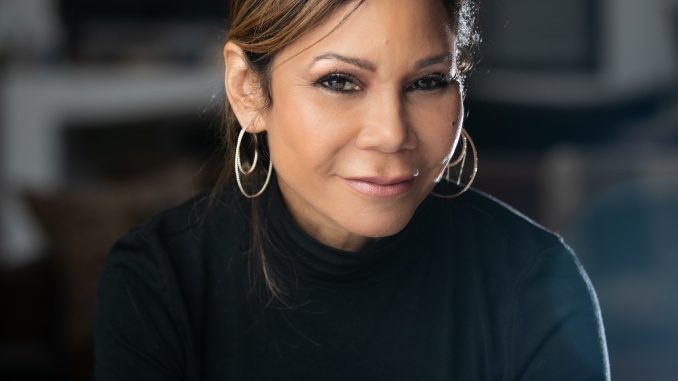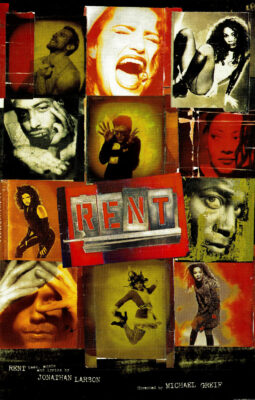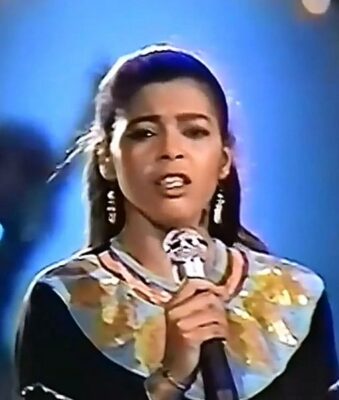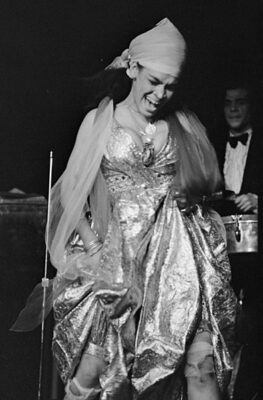
When Daphne Rubin-Vega was nine, the aspiring performer saw an ad in Backstage magazine looking for actors to audition for roles in an upcoming production of The Princess and The Pea. The cattle call was being held not too far from where she was growing up in Hell’s Kitchen while living on 44th Street between The Actor’s Studio and what became The New Dramatists. While the outcome was not ideal, it forged in her a tenacity that later led to greater successes, first playing a Tony-nominated role as Mimi in the original 1996 Broadway production of Rent.
(Photo by Michael Mansfield)
And more recently, playing Daniela, the beauty shop owner in the 2021 film adaptation of In the Heights.
“I didn’t even know what The Princess and the Pea was,” she recalled. “I went on the audition and I was the only kid there. They said, ‘Oh honey, this isn’t with children, it’s for children.’ And they were laughing. They thought it was so amusing and I was devastated. They asked how old I was and when I said I was nine, they told me to come back in nine more years. To me, that was like saying come back in a whole other lifetime, you know what I’m saying? I forgot how devastated I was.”
 The perseverance the Panamanian immigrant showed yielded a hard-fought career that’s found her showing up in everything from the Apple TV+ series The Changeling and starring opposite the late Philip Seymour in the 2010 film Jack Goes Boating to starring in her own one-woman show Empanada Loca and currently preparing to star opposite Tim Daly in an Off-Broadway revival of Tennessee Williams’ Night of the Iguana. It’s a creative résumé that led CUNY’s Medgar Evers College to award Rubin-Vega the 2023 Latina Trailblazer of the Year Award. It’s an honor she doesn’t take lightly.
The perseverance the Panamanian immigrant showed yielded a hard-fought career that’s found her showing up in everything from the Apple TV+ series The Changeling and starring opposite the late Philip Seymour in the 2010 film Jack Goes Boating to starring in her own one-woman show Empanada Loca and currently preparing to star opposite Tim Daly in an Off-Broadway revival of Tennessee Williams’ Night of the Iguana. It’s a creative résumé that led CUNY’s Medgar Evers College to award Rubin-Vega the 2023 Latina Trailblazer of the Year Award. It’s an honor she doesn’t take lightly.
“This award means that people who look like me are paying attention and that there’s an optic on what I do that can serve to remind you that you’re here too,” Rubin-Vega said. “It also reminds me that I did not roll off a log and get here. I have been really fortunate. You can even say blessed and highly favored. Using the hands that were dealt me and really making the best out of them. I can’t tell you how I feel about it. It’s corny when people thank their agent, parents or higher power. First of all, I thank mi gente that are paying attention. And the fact that an institution with the name Medgar Evers on it [is honoring me] is particularly powerful because Medgar Evers was a solid example of someone who walked his talk and it cost him his life. Just the proximity is a high honor. I don’t risk my life. God knows, speaking the truth these days means it might become a life risk that things are less democratic than I thought they were.”
 Born in Panama City, Panama, Rubin-Vega is the daughter of Daphne Corona, a nurse, and Jose Mercedes Vega, a carpenter. Her stepfather Leonard Rubin was a writer. Her mother moved from Panama to the United States with her children when Daphne was only two years old, and died eight years later. Suffice it say, it was a rough go for the tween Rubin-Vega, who was grieving while trying to figure her identity through creative pursuits.
Born in Panama City, Panama, Rubin-Vega is the daughter of Daphne Corona, a nurse, and Jose Mercedes Vega, a carpenter. Her stepfather Leonard Rubin was a writer. Her mother moved from Panama to the United States with her children when Daphne was only two years old, and died eight years later. Suffice it say, it was a rough go for the tween Rubin-Vega, who was grieving while trying to figure her identity through creative pursuits.
“I lost my mom and New York City was cracked in the ‘80s,” she said. “I’d always been into dance and I always took dance classes. When I was little, my mom put me in a dance class when I started to live here. It was a ballet school and I didn’t have the body, so I started taking Afro-Caribbean, Afro-Cuban, Afro-jazz—Charles and Ella Moore were these earliest teachers that were so supportive. They said I was good and that this fits you and works. There was something about competition, excellence and perfection that I could never measure up to in the ballet environment. But when it came to Afro-Caribbean dance, it was in my bones. I didn’t have to have the perfect neck. My legs didn’t have to be a certain way. I could be there and it was in my gut and my soul. So it was more informed by soul rather than angle and technique. I was just thinking of Charles and Ella more today because I didn’t have all these teachers who were so supportive. I had a lot of negativity, you know what I mean? It’s good to remember the people with the voices of empowerment.”
In grasping the gravity of being a role model, Rubin-Vega is quick to recognize whose shoulders she’s standing on while proving to be a role model for the next generation.
“When I was coming around, there was Rita, Cheeta and a lot of other women that changed their names and you couldn’t be sure,” she said. “Thank God for Irene Cara. And there are more and they should be recognized, but that’s just to name a few.”
Here are a few more of those Latinas who inspired a young Daphne Rubin-Vega.

(Photo by Steven L. Smith/CC BY 3.0 DEED)
Irene Cara (March 18, 1959 to November 22, 2022)
“Thank God for Irene Cara. I was going to P.S. 51 and went on a field trip and saw her in a production of The Me Nobody Knows when I was in fifth grade. I saw Irene and never forget her because I could see me in her.”

(CC BY 2.0 DEED)
Bianca Jagger (May 2, 1945 to present)
“I loved her because she was gorgeous and married to a rockstar!! (My ambitions and virtue weren’t always that clear…”

(Public domain/Photo by Charlotte Brooks)
La Lupe (a.k.a. Lupe Victoria Yoli Raymond) (December 23, 1936 to February 29, 1992)
“She was unapologetically committed to drama in her performance. My character of Mimi in Rent got a lot from La Lupe.”
Daphne Rubin-Vega will be accepting the 2023 Latina Trailblazer of the Year Award on Friday, October 6 at CUNY Medgar Evers College at 6:30 p.m. Click here to register for this free event.

